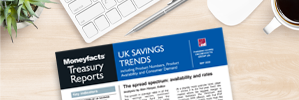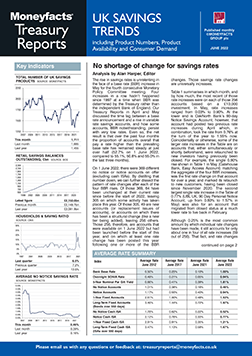Rachel Springall, Finance Expert at Moneyfacts, said:
“Interest rates have risen across the savings spectrum for a fifth consecutive month, promising signs for savers who either want some flexibility or a guaranteed return on their cash. It has been over six months since the first of five base rate rises were announced, and while rate competition among many savings providers has been prevalent, just 51% of the savings market pays above 1.25%, the current Bank of England base rate. The market clearly has more room for growth but, as we have seen in the past, a base rate rise does not always get passed on to consumers. However, it should encourage savers to compare deals and switch.
“Savers looking to maximise their interest earned but wanting to avoid locking their cash away over the longer-term, could choose a one-year fixed bond, an area of the savings market which has improved enormously. Since the start of 2022, the average one-year fixed bond rate has more than doubled, up from 0.80% to 1.75%, largely fuelled by competition among challenger banks. Such rigorous rate changes last month resulted in a drop to the average shelf life of a fixed bond to 33 days, down from 44 a month ago. Savers coming off a one-year bond wanting to fix for an equivalent bond could earn 1.23% more on average today (1.75%) than what was available 12 months ago (0.52%).
“The substantial uplift to both one-year and longer-term fixed rates may well be enticing savers to fix, as according to the Bank of England, there was an inflow of £1.65 billion into interest-bearing time deposits, the highest monthly inflow figure since October 2020 (£2.17 billion). Over the past two years, outflows have been a more common sight, and it has been interest-bearing sight deposits, such as easy access accounts, seeing much larger volumes of deposits. Indeed, between January and May 2022, there has been an inflow of £20 billion into interest-bearing sight deposits, compared to £2.5 billion for interest-bearing time deposits. However, consumers have clearly changed their attitudes to putting money aside this year with changing circumstances, as during the same period in 2021, there was an inflow of £56.3 billion in interest-bearing sight deposits.
“Cash ISA rates are encouragingly on the rise, both across easy access, notice accounts and fixed, but savers will often find that they can get a higher rate outside of an ISA wrapper. Due to the rising cost of living, savers might decide to dip into an ISA pot that permits access, but the shifting appeal of a Cash ISA has already been noted in Bank of England data, where between January and May 2022, there was an outflow of £4.5 billion, much higher than the equivalent period in 2021 where there was a net outflow of almost £1.6 billion. Cash ISAs are still worth considering for their longer-term tax-free benefits, and these can be a haven for those who feel the stock market is too risky.
“Savers unsure of which type of account to choose in the coming weeks may want to consider a notice account as a compromise between easy access and fixed bonds, particularly as notice accounts now pay the highest average return recorded in almost three years. Consumers and providers alike would be wise to compare deals in the top rate tables frequently. As interest rate rises continue to shuffle product positions, deals are not guaranteed to sit on the shelf for long.”
Rachel Springall, Finance Expert at Moneyfacts, said:
“Interest rates have risen across the savings spectrum for a fifth consecutive month, promising signs for savers who either want some flexibility or a guaranteed return on their cash. It has been over six months since the first of five base rate rises were announced, and while rate competition among many savings providers has been prevalent, just 51% of the savings market pays above 1.25%, the current Bank of England base rate. The market clearly has more room for growth but, as we have seen in the past, a base rate rise does not always get passed on to consumers. However, it should encourage savers to compare deals and switch.
“Savers looking to maximise their interest earned but wanting to avoid locking their cash away over the longer-term, could choose a one-year fixed bond, an area of the savings market which has improved enormously. Since the start of 2022, the average one-year fixed bond rate has more than doubled, up from 0.80% to 1.75%, largely fuelled by competition among challenger banks. Such rigorous rate changes last month resulted in a drop to the average shelf life of a fixed bond to 33 days, down from 44 a month ago. Savers coming off a one-year bond wanting to fix for an equivalent bond could earn 1.23% more on average today (1.75%) than what was available 12 months ago (0.52%).
“The substantial uplift to both one-year and longer-term fixed rates may well be enticing savers to fix, as according to the Bank of England, there was an inflow of £1.65 billion into interest-bearing time deposits, the highest monthly inflow figure since October 2020 (£2.17 billion). Over the past two years, outflows have been a more common sight, and it has been interest-bearing sight deposits, such as easy access accounts, seeing much larger volumes of deposits. Indeed, between January and May 2022, there has been an inflow of £20 billion into interest-bearing sight deposits, compared to £2.5 billion for interest-bearing time deposits. However, consumers have clearly changed their attitudes to putting money aside this year with changing circumstances, as during the same period in 2021, there was an inflow of £56.3 billion in interest-bearing sight deposits.
“Cash ISA rates are encouragingly on the rise, both across easy access, notice accounts and fixed, but savers will often find that they can get a higher rate outside of an ISA wrapper. Due to the rising cost of living, savers might decide to dip into an ISA pot that permits access, but the shifting appeal of a Cash ISA has already been noted in Bank of England data, where between January and May 2022, there was an outflow of £4.5 billion, much higher than the equivalent period in 2021 where there was a net outflow of almost £1.6 billion. Cash ISAs are still worth considering for their longer-term tax-free benefits, and these can be a haven for those who feel the stock market is too risky.
“Savers unsure of which type of account to choose in the coming weeks may want to consider a notice account as a compromise between easy access and fixed bonds, particularly as notice accounts now pay the highest average return recorded in almost three years. Consumers and providers alike would be wise to compare deals in the top rate tables frequently. As interest rate rises continue to shuffle product positions, deals are not guaranteed to sit on the shelf for long.”











